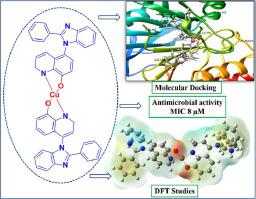Chemical Data Collections Pub Date : 2021-09-23 , DOI: 10.1016/j.cdc.2021.100777 A.M. Anusuya 1 , B.S. Krishna 1 , S.B. Benaka Prasad 2 , M.S. Raghu 3 , M.K. Prashanth 4 , Prakash Krishnaiah 5 , Fahad A. Alharthi 6

|
A novel 5-(2-phenyl-1H-benzo[d]imidazol-1-yl)quinolin-8-ol ligand (PBIQ) ligand was used to synthesize a series of Mn(II), Co(II), Ni(II), Cu(II), and Zn(II) complexes. Elemental analysis, FTIR, 1H NMR, UV-Visible and mass spectra were utilized to characterize the newly synthesized ligand and its transition metal complexes. The antimicrobial activity of the ligand and complexes were evaluated against four bacterial and one fungal strain using the minimum inhibitory concentration method (MIC). The minimum inhibition concentration observed was compared against the standard antibiotic rifampicin and the antifungal drug fluconazole. The studies revealed that Cu(II) and Zn(II) complexes are more effective against tested bacterial and fungal strains compared to the ligand and other complexes. Molecular docking techniques revealed that the Cu(II)-PBIQ complex associated with the target protein (PDB ID: 4HL2) had a greater binding affinity with π-σ, π-alkyl and hydrophobic interactions. Density function theory (DFT) calculations were applied to evaluate the optimized geometrical structures and to calculate the global reactivity descriptors of the more active Cu(II) and Zn(II) complexes. Besides, the in-silico pharmacokinetics showed that all the examined metal complexes compounds obeyed Lipinski's Rule of five with one violation.
中文翻译:

5-(2-phenyl-1H-benzo[d]imidazol-1-yl)quinolin-8-ol 的新型过渡金属配合物作为活性药效团:实验和计算探索
一种新型的5-(2-苯基-1H-苯并[d]咪唑-1-基)喹啉-8-醇配体(PBIQ)配体用于合成一系列Mn(II)、Co(II)、Ni( II)、Cu(II) 和 Zn(II) 络合物。元素分析、FTIR、1H NMR、UV-可见光和质谱被用来表征新合成的配体及其过渡金属配合物。使用最小抑制浓度法 (MIC) 评估配体和复合物对四种细菌和一种真菌菌株的抗菌活性。将观察到的最小抑制浓度与标准抗生素利福平和抗真菌药物氟康唑进行比较。研究表明,与配体和其他配合物相比,Cu(II) 和 Zn(II) 配合物对测试的细菌和真菌菌株更有效。分子对接技术表明,与目标蛋白(PDB ID:4HL2)相关的 Cu(II)-PBIQ 复合物与 π-σ、π-烷基和疏水相互作用具有更大的结合亲和力。密度函数理论 (DFT) 计算用于评估优化的几何结构并计算更活跃的 Cu(II) 和 Zn(II) 配合物的全局反应性描述符。此外,计算机内药代动力学表明,所有被检测的金属配合物化合物均符合利平斯基五法则,其中一次违反。密度函数理论 (DFT) 计算用于评估优化的几何结构并计算更活跃的 Cu(II) 和 Zn(II) 配合物的全局反应性描述符。此外,计算机内药代动力学表明,所有被检测的金属配合物化合物均符合利平斯基五法则,其中一次违反。密度函数理论 (DFT) 计算用于评估优化的几何结构并计算更活跃的 Cu(II) 和 Zn(II) 配合物的全局反应性描述符。此外,计算机内药代动力学表明,所有被检测的金属配合物化合物均符合利平斯基五法则,其中一次违反。


























 京公网安备 11010802027423号
京公网安备 11010802027423号